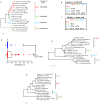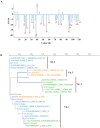Evaluation of the Deletion of African Swine Fever Virus E111R Gene from the Georgia Isolate in Virus Replication and Virulence in Domestic Pigs
- PMID: 39339977
- PMCID: PMC11437470
- DOI: 10.3390/v16091502
Evaluation of the Deletion of African Swine Fever Virus E111R Gene from the Georgia Isolate in Virus Replication and Virulence in Domestic Pigs
Abstract
African swine fever virus (ASFV) is the causative agent of an often lethal disease in domestic pigs, African swine fever (ASF). ASF is currently a pandemic disease challenging pig production in Eurasia. While the ASFV genome encodes for over 160 proteins, the function of most of them are still not characterized. Among those ASF genes with unknown functions is the E111R gene. It has been recently reported that the deletion of the E111R gene from the genome of the virulent Chinese field isolate SY18 strain produced a reduction of virus virulence when pigs were inoculated at relatively low doses. Conversely, we report here that deletion of the ASFV gene E111R in the Georgia 2010 isolate does not alter the virulence of the parental virus in experimentally inoculated pigs. A recombinant virus lacking the E111R gene, ASFV-G-∆E111R was intramuscularly (IM) inoculated in domestic pigs at a dose of 102 HAD50 of ASFV-G-∆E111R and compared with animals that received a similar dose of virulent ASFV-G. Both, animals inoculated with either the recombinant ASFV-G-∆E111R or the parental virus developed a fatal form of the disease and were euthanized around the 6th-7th day post-inoculation (dpi).
Keywords: ASF; ASFV; ASFV E111R gene; ASFV virulence; African swine fever virus; recombinant virus.
Conflict of interest statement
Author Douglas P. Gladue was employed by the company Seek Labs. The remaining authors declare that the research was conducted in the absence of any commercial or financial relationships that could be construed as a potential conflict of interest.
Figures









References
-
- Tulman E.R., Delhon G.A., Ku B.K., Rock D.L. African Swine Fever Virus. In: Etten V., editor. Lesser Known Large dsDNA Viruses. Volume 328. Springer; Berlin/Heidelberg, Germany: 2009. pp. 43–87. Current Topics in Microbiology and Immunology. - PubMed
-
- Borca M.V., Ramirez-Medina E., Silva E., Vuono E., Rai A., Pruitt S., Holinka L.G., Velazquez-Salinas L., Zhu J., Gladue D.P. Development of a Highly Effective African Swine Fever Virus Vaccine by Deletion of the I177L Gene Results in Sterile Immunity against the Current Epidemic Eurasia Strain. J. Virol. 2020;94:e02017-19. doi: 10.1128/JVI.02017-19. - DOI - PMC - PubMed
Publication types
MeSH terms
Substances
Associated data
- Actions
LinkOut - more resources
Full Text Sources

